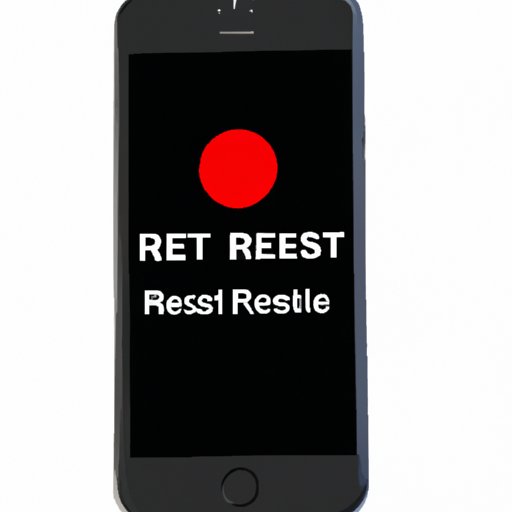Introduction
Have you ever experienced a sudden malfunction, an unresponsive screen, or an app that doesn’t work on your iPhone? The most common solution to fix these kinds of problems is to reset your phone. Resetting your iPhone not only resolves issues, but also improves its overall performance. This article provides a comprehensive guide on how to reset your iPhone with various methods to tackle different issues.
Step-by-Step Guide
The following are the steps to follow to reset your iPhone:
First, open the settings app on your iPhone and click on the General option. From there, scroll down and locate the Reset option near the bottom of the page. Click on Reset, and you will be given several options for resetting your phone. You can choose to reset all settings, erase all content and settings, reset network settings, or reset keyboard dictionary.
If you decide to erase all content and settings, your phone will be set back to the original factory settings. Before proceeding, ensure that you have backed up your iPhone data through iCloud, so that you can easily restore the data back on your iPhone.
To erase your iPhone, simply confirm that you want to erase the device, enter your passcode or Apple ID password, and click on Erase iPhone. This process may take some time, so be patient. Once the reset is complete, your iPhone should restart automatically, and you can start setting it up again as if it were a new device.
Check out the screenshots below:


Video Tutorial
To make the reset process even easier to understand, here’s a helpful video tutorial below:
As you can see, resetting your iPhone can be a straightforward process, and with visual aids, even simpler. Just like the step-by-step guide above, the video walks you through the reset process in a clear, concise way.
Comparison of Resetting Methods
Not all iPhone issues need the same kind of reset. The following are the different methods you can use to reset your iPhone:
Soft Reset
A soft reset is the simplest form of resetting your iPhone. This method clears some of the phone’s cache and refreshes the device. It involves holding down the power button for a few seconds until the slide to power off button appears. You can then slide this button to turn the phone off. Alternatively, if the phone is unresponsive, hold down both the side button and the volume down button until the phone turns off and the Apple logo appears.
Hard Reset
A hard reset, on the other hand, is a more forceful method of resetting your iPhone. This method deletes all your personal data from the phone and sets it back to the original factory settings. If a soft reset does not fix the issue, it’s likely that a hard reset will. You can perform this reset through the General settings in your iPhone, as described in the step-by-step guide above.
Troubleshooting Common Problems
If your iPhone is experiencing some common problems such as apps freezing, slow performance, or unresponsive screens, here are some solutions:
Apps Freezing or Crashing
If your phone freezes when using a certain app, try restarting the phone or resetting the app. You can restart the app by double-tapping the home button and swiping up on the app’s preview window.
Slow Performance
If your iPhone is performing slower than usual, try clearing out some of your phone’s storage space, disabling location services, or turning off background app refresh.
Unresponsive Screen
If your iPhone’s screen is not responsive, you can try force-quitting the application causing the problem. You can also try a hard reset to fix bigger issues that the soft reset can’t take care of.
Customizing the Reset Process
Customizing the reset process provides you the flexibility to restore your iPhone to an earlier backup or to delete only specific data. Here are some tips to consider:
Factory Reset or Partial Reset
A “factory reset” wipes all of your phone’s data, restoring it back to its original, out-of-the-box state. A “partial reset,” on the other hand, erases just some data, like your device’s network settings or keyboard settings. After resetting your phone, you can choose how much, or how little, data you restore from your previous backups.
Back Up Data Before Resetting
Before resetting your iPhone, it’s crucial that you back up all of your important data. This can be done through iCloud or through iTunes. This way, once your device is wiped clean, you can restore the data on your iPhone without losing any of your important data.
Choose Which Data to Restore After Reset
You don’t have to restore all the data. You can choose what specific apps, photos, contacts and other information you want to come back to your phone. Selecting and backing up what matters most will save you the hassle of having to manually delete stuff you don’t need.
Conclusion
Resetting your iPhone can seem daunting, but by following these easy steps and tips provided in this article, you can conveniently troubleshoot most of your device’s issues. In case of persistent problems, don’t hesitate to seek out an expert for assistance. By taking a few simple steps, and sparing a few minutes of your time, you can fully reset your iPhone and enjoy its smooth performance as it was when you first bought it.
